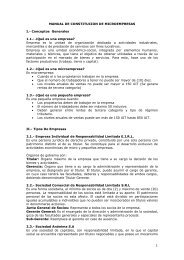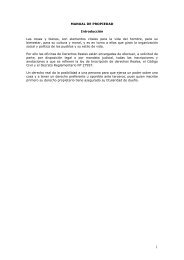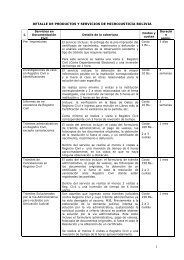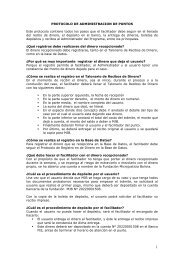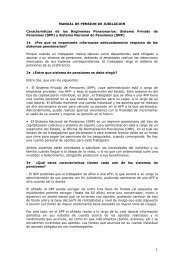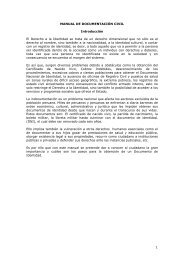ICISS report - International Coalition for the Responsibility to Protect
ICISS report - International Coalition for the Responsibility to Protect
ICISS report - International Coalition for the Responsibility to Protect
You also want an ePaper? Increase the reach of your titles
YUMPU automatically turns print PDFs into web optimized ePapers that Google loves.
The <strong>Responsibility</strong> <strong>to</strong> <strong>Protect</strong> 65<br />
alongside peacekeepers, in order <strong>to</strong> assist in <strong>the</strong> resuscitation of national law en<strong>for</strong>cement<br />
agencies, have not been equipped <strong>to</strong> address <strong>the</strong> issue of law en<strong>for</strong>cement in a “not<br />
crime–not war” environment. The military has remained <strong>the</strong> only viable instrument<br />
although this reality has been obscured by <strong>the</strong> notion of peace as <strong>the</strong> anti<strong>the</strong>sis of war.<br />
Five <strong>Protect</strong>ion Tasks<br />
7.42 Five analytically distinct kinds of protection tasks that emerge from <strong>the</strong>se posten<strong>for</strong>cement<br />
experiences are worth highlighting here. The first is <strong>the</strong> protection of minorities.<br />
This operational challenge is particularly important when civilians return <strong>to</strong> terri<strong>to</strong>ries<br />
where ano<strong>the</strong>r ethnic group is in <strong>the</strong> majority. The Balkans have provided numerous<br />
examples of <strong>the</strong> difficulties, and <strong>the</strong> relatively low number of refugees and IDPs who have<br />
returned is telling.<br />
7.43 The second major protection task is security sec<strong>to</strong>r re<strong>for</strong>m. The focus of such tasks has<br />
been <strong>to</strong> assist local authorities in <strong>the</strong>ir own process of security sec<strong>to</strong>r trans<strong>for</strong>mation.<br />
Bilateral and multilateral donors alike have sought <strong>to</strong> influence <strong>the</strong> direction of change,<br />
establish good practices, and transfer knowledge and insights <strong>to</strong> <strong>the</strong> new authorities. The<br />
importance as well as <strong>the</strong> difficulty of such ef<strong>for</strong>ts <strong>to</strong> recruit and train local police and<br />
re<strong>for</strong>m <strong>the</strong> penal and judiciary systems have been evident in countries as diverse as Haiti,<br />
Rwanda and East Timor. The problems are especially difficult in situations where trained<br />
personnel have been killed or fled in large numbers <strong>to</strong> avoid violence.<br />
7.44 In this respect, an interim challenge concerns <strong>the</strong> use of civilian police. In fact, civilian<br />
police now number second only <strong>to</strong> soldiers in UN operations. In light of <strong>the</strong> post-war<br />
conflicts and need <strong>for</strong> impartiality, <strong>the</strong> need <strong>for</strong> civilian police operations dealing with<br />
intra-state conflict is likely <strong>to</strong> remain a high priority in helping war-<strong>to</strong>rn societies res<strong>to</strong>re<br />
conditions <strong>for</strong> social, economic and political stability. The difficulty of recruiting international<br />
police is a central and crucial constraint, particularly in light of <strong>the</strong> need <strong>to</strong> re<strong>for</strong>m<br />
and restructure local police <strong>for</strong>ces in addition <strong>to</strong> advising, training, and moni<strong>to</strong>ring<br />
new recruits.<br />
7.45 The third main task is disarmament, demobilization, and reintegration. Although<br />
reintegration is key <strong>to</strong> longer-term peace building, and ultimately <strong>the</strong> resumption of <strong>the</strong><br />
path <strong>to</strong> economic and social development, <strong>the</strong> focus here is on <strong>the</strong> security and protection<br />
of civilians. As reflected in Security Council resolutions and mission mandates, <strong>the</strong> key <strong>to</strong><br />
stabilization has always been <strong>the</strong> demobilization of <strong>for</strong>mer combatants. The unstated<br />
purpose of stabilization measures has been <strong>to</strong> wrest power and <strong>the</strong> means of violence from<br />
local militias and warlords and <strong>to</strong> re-centralize it at a much higher level. In o<strong>the</strong>r words, <strong>the</strong><br />
success of <strong>the</strong> whole intervention process has hinged on <strong>the</strong> degree <strong>to</strong> which warring<br />
factions can be effectively disarmed. However, disarmament has been one of <strong>the</strong> most<br />
difficult tasks <strong>to</strong> implement. It has been extremely hard <strong>to</strong> collect all weapons, even at<br />
<strong>the</strong> end of an armed struggle, when <strong>the</strong> remaining conditions of insecurity create high<br />
incentives <strong>for</strong> <strong>the</strong> maintenance and acquisition of light weapons and small arms by <strong>the</strong><br />
community at large. Physical security and economic needs fuel a trade in small arms long<br />
after <strong>the</strong> withdrawal of intervention <strong>for</strong>ces.<br />
7.46 All disarmament commitments in peace processes have tended, at least at <strong>the</strong> outset,<br />
<strong>to</strong> be based on consent – regardless of whe<strong>the</strong>r <strong>the</strong> external <strong>for</strong>ces deploy under a Chapter<br />
VI or VII mandate. However, <strong>the</strong> idea of voluntary disarmament is soon challenged by issues<br />
such as <strong>the</strong> security and economic livelihood of combatants thinking about turning in <strong>the</strong>ir<br />
weapons, along with <strong>the</strong> normally insufficient number of peace support <strong>for</strong>ces. Faced with



